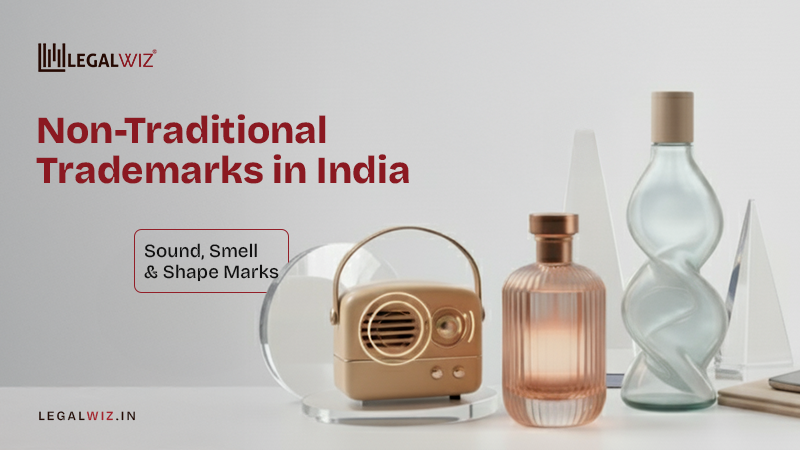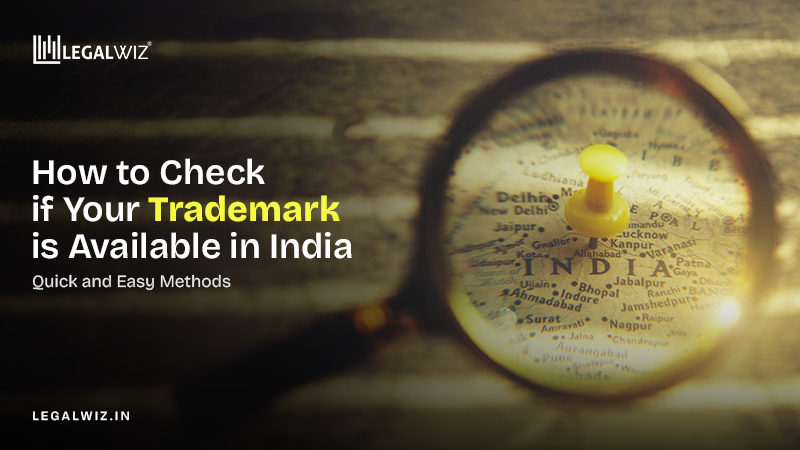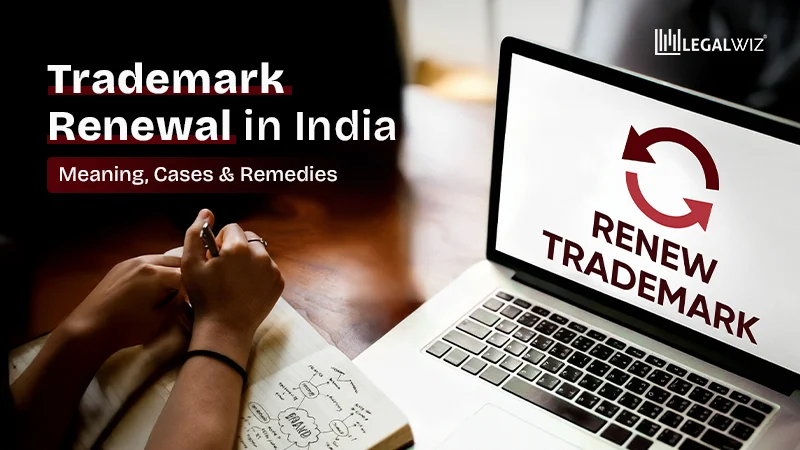Non-Traditional Trademarks in India: Sound, Smell & Shape Marks
Picture this: you walk into a room, and the smell of Vicks VapoRub instantly tells you what’s in the air, even before seeing the jar. Or you hear that Amul “The Taste of India” jingle, and you instantly know the brand. Sounds like sci-fi? Welcome to the world of non-traditional trademarks.
India’s markets are buzzing with copycats. A simple logo isn’t enough anymore. Sneaky imitators can confuse customers with similar names or designs. But what if you could protect more than your logo? What if your brand had a whistle, a shape, or a scent all its own? Feels like a superpower, right? Well, it’s real, non-traditional trademark registration lets you do exactly that.
By the end of this adventure, you’ll know how sounds, scents, and shapes can lawfully become your brand’s hidden weapon. Ready to leave your competitors scratching their heads? Let’s dive in.
1. What Are Non-Traditional Trademarks?
Non-traditional trademarks are exactly what they sound like: marks that aren’t your usual words, logos, or slogans. Think outside the box… literally. These are the sensory cues, sounds, smells, shapes- that make people instantly recognize your brand, even without seeing your name.
Globally, you’ve got the Intel bong, the MGM lion roar, and even Coca-Cola’s unique bottle shape. In India, examples are popping up too: the Amul jingle, the distinctive Vicks VapoRub scent, or the curvy shape of certain Fevicol glue bottles.
Why are businesses exploring them? Because in today’s crowded market, standing out is everything. These trademarks build emotional connections, make brands memorable, and provide legal protection against those sneaky imitators who love copying logos and colors. Basically, they let your brand have personality… and a little superpower too.
Also read: Trademark for Soft Drinks, Juices & Beer: Class 32
2. Trademarking Sound in India: When Brands Sing
Ever thought a sound could belong to a brand? In India, it can. A sound mark is any tune, jingle, or audio logo that instantly identifies your brand to consumers. The legal framework allows you to register such sounds as trademarks; yes, your brand can literally sing its way into people’s minds.
In India, the Fevicol tune or the Vodafone “Hello Madhu” ringtone is instantly recognizable; hear them once, and you know exactly which brand is speaking.
So, how do you register a sound mark in India?
- Audio submission: You’ll need to provide a recording of the sound. No humming in the shower, sorry.
- Distinctiveness requirement: The sound must clearly identify your brand and not just be a generic tune anyone could use.
- Pro tip: Make it catchy, not ear-piercing. Your goal is to be memorable, not make people hit the skip button.
So, your brand’s jingle becomes so iconic that people hum it before they even see your logo. That’s the power of a sound mark, your brand literally speaking (or singing) for itself.
To save you from scratching your head, check out our detailed blog on what can be Trademarked; it’s got the full lowdown on what can legally become your brand’s claim to fame.
3. Trademark Your Brand’s Smell Marks: The Nose Knows
Has the aroma ever been enough to tell you which brand was present in a room? scent markings, or logos that reach your sense of scent before your sight, work their power in this way. This is still something of unexplored terrain in India, which adds an intriguing and challenging element.
It could be challenging to trademark a perfume since you’ll have to prove that it’s not only a common or valuable aroma, but one that only your company possesses. People can instantly recognize the brand of a perfume or air freshener just by its scent.
Curious why trademarking your brand isn’t just a nice-to-have? Dive into this landmark case that’s all about deceptively similar marks. It’s a perfect lesson in why registering your trademark isn’t just smart, it’s essential. Read the trademark face-off between Starbucks and Sardarbakhsh, and see how one brand’s identity could have ended up in serious hot water.
To explain it in simpler terms:
- Distinctness: The aroma shouldn’t only be pleasant; it should convey your brand’s message.
- Non-functionality: A scent that is fundamental to the product’s operation cannot be trademarked.
- Evidence: You need to prove that people relate the smell to your brand.
The best part? Memories of brands may become ingrained in people’s minds. A neighboring shop isn’t necessary; all it takes is a scent for your brand to magically appear in someone’s imagination. Most brands can only dream of having sensory superpowers like that.
4. Time to Trademark Your Brand’s Shape Marks in 2025
Isn’t it amazing when you pick up a Thums Up bottle or a uniquely shaped Parle-G biscuit pack and instantly know the brand without reading a label? That’s the magic of shape marks, trademarks that make your product instantly recognizable just by its form.
Legally, shape marks in India must be non-functional, distinctive, and recognized by consumers. That means your product’s shape can’t just be practical; it has to scream “This is me!” in the marketplace.
How do you register one? You’ll need:
- Visual representation: Clear images showing the unique shape.
- Proof of distinctiveness: Show that customers associate the shape with your brand.
- Case studies: Learn from brands that nailed it, like Thums Up’s contoured bottle or Parle-G’s iconic biscuit pack.
The fun part? Packaging isn’t just about holding your product; it’s a silent salesperson. One glance at your shape, and consumers already know who you are. Trademarking it? That’s giving your brand a personality nobody else can copy.
Also read: What’s the Difference Between Brand and Trademark
5. Challenges & Legal Hurdles for Non-traditional Trademarking
So, you’re ready to make your brand sing, smell, or strike a pose, but it’s not all smooth sailing. Non-traditional trademarks come with their own set of hurdles.
| Challenge | What It Means | Our Take |
| Distinctiveness vs. Functionality | Your sound, scent, or shape must identify your brand, not just serve a practical purpose. | Think of it as your brand’s personality, your jingle can’t just be “useful,” it has to shout “This is me!” |
| Evidence Requirements | You must prove that consumers actually recognize your brand through the mark. | Don’t just say it’s catchy, show surveys, demos, or social media love. Make people see (or smell/hear) your genius. |
| Enforcement Difficulties | Copycats might tweak your mark and try to sneak by. | Document everything, keep an eye on competitors, and swoop in like a hawk when someone dares touch your sensory turf. |
Non-traditional trademarks are like giving your brand superpowers, but even superheroes need strategy, proof, and a little vigilance.
6. Tips for Businesses Wanting Non-Traditional Marks
So, you’re ready to give your brand some superpowers. Here’s how to make sure it actually works.
- Start Small: Don’t try to turn your brand into a full sensory orchestra at once. Pick one trait, a sound, a scent, or a shape, and make it unforgettable. Think of it as your brand’s signature move.
- Document Everything: Keep receipts, recordings, photos, basically proof that your quirky mark exists and people recognize it. This is your superhero dossier when the legal battles come knocking.
- Seek Professional Help Early: Non-traditional trademarks are a niche playground in India. The rules can be tricky, and missing a step could mean your brand’s superpower stays unprotected. A trademark expert is like your sidekick; don’t skip them.
- Fun Thought Experiment: How would people know your product exists without seeing the logo? Sure, it’s essential to learn all about trademarking your logo, but building a brand legacy means going beyond the logo. Could they hum your jingle, sniff your scent, or spot your unique bottle shape from a mile away? If yes, congratulations, you’ve got a sensory identity in the making.
Remember, this is your brand’s moment to shine in ways no one else can copy, so go ahead, make it unforgettable.
Conclusion: Trademarking is Beyond the Logo
Think about it, logos and names have been the bread and butter of branding for decades. But in 2025, when customers are bombarded with lookalikes and copycats, that just isn’t enough. Non-traditional trademark registration in India—whether it’s the pop of a soda can, the whiff of a signature perfume, or packaging so unique you could spot it blindfolded—is the next frontier. They don’t just grab attention; they stick in memory and give your brand a legal shield no imitator can easily break.
For businesses in India, this is the perfect time to think bigger. With competition heating up, protecting your sound, scent, or shape could be the very edge that sets you apart. It’s not just clever marketing, it’s a smart legal strategy. So, don’t box your brand into a logo. Explore the wild, creative side of trademarks and see how far your identity can travel. And if the legal nitty-gritty feels daunting, LegalWiz is here to make the process simple, clear, and a little more fun, because your brand deserves more than just a logo; it deserves a legacy.
Frequently Asked Questions
What are non-traditional trademarks?
They’re trademarks that go beyond words, logos, or slogans, like sounds, smells, and product shapes that uniquely identify a brand.
Are non-traditional trademarks recognized in India?
Yes, India recognizes sound and shape marks. Smell marks are still tricky and not commonly accepted due to proof and enforcement challenges.
Can you really trademark a sound in India?
Absolutely. The Yahoo! yodel was among the first sound marks registered in India. If it’s distinctive and not generic, it can be protected.
What about smells; are they trademarked anywhere?
Globally, yes. For example, a floral fragrance was trademarked for darts in the EU. In India, smell marks haven’t gained legal traction yet.
Why should a business bother with non-traditional trademarks?
Because they build a stronger brand recall. Think of Microsoft Teams’ caller tune or Coca-Cola’s bottle shape, people recognize them instantly without even reading the name.
What are the biggest challenges in registering non-traditional marks in India?
Proving distinctiveness, non-functionality, and providing clear evidence. For sounds, an audio file is needed; for shapes, clear drawings; for smells, this is where the law gets fuzzy.
How can businesses get started with these marks?
Pick one distinctive sensory trait, document it, and consult a trademark professional early. Firms like LegalWiz can help you navigate the tricky paperwork and legal hurdles.

Sapna Mane
Sapna Mane is a skilled content writer at LegalWiz.in with years of cross-industry experience and a flair for turning legal, tax, and compliance chaos into clear, scroll-stopping content. She makes sense of India’s ever-changing rules—so you don’t have to Google everything twice.







